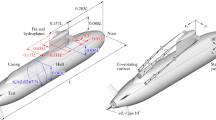Abstract
A method aimed at the development of an America’s Cup racing yacht bulb is developed and validated against experimental data. The method relies heavily on Reynolds Averaged Navier Stokes computational fluid dynamics (CFD) and also factors in gravitational and aerodynamics effects through the use of a Velocity Prediction Program. Initial extensive use of towing tank results is made to be able to validate the CFD solution and thus develop a solid ground for predictive work. Then, in order to narrow down the focus on bulb developments, decoupled hypotheses are made on the influence of the hull and free surface wave. The development of a detailed performance analysis chart of a known base bulb allows the use of a relatively small series of CFD simulations together with physical hypotheses to assess any given bulb performance relative to the known base. The discussion of the results on a specific development highlights the promises and limitations of the method; final full scale results are discussed and analysed as well.











Similar content being viewed by others
References
Batdorf M, Freitag Lori A, Ollivier-Gooch Carl F (1997) A computational study of the effect of unstructured mesh quality on solution efficiency. In: Proceedings of the 13th AIAA computational fluid dynamics conference
Bradley RG (1998) CFD validation philosophy AGARD, validation of computational fluid dynamics, vol 1. In: Symposium Papers and Round Table Discussion, no. 437, pp 1.1–1.6
Brown M, Campbell I, Robinson J (2002) The accuracy and repeatability of tank testing, from experience of ACC yacht development. In: Proceedings of the 1st high performance yacht design conference RINA
Campbell I, Robinson J, Brown M (2002) The accuracy and repeatability of tank testing, from experience of ACC yacht development. In: Proceedings of the 1st high performance yacht design conference, Auckland, New Zealand RINA
Challenger of Record and Defender for America’s Cup XXXII (2003) America’s Cup Class Rule, Version 5.0. America’s Cup Management
Claughton A, Oliver JC (2003) Developments in hydrodynamic force models for Velocity Prediction Programs. In: Proceedings of the RINA international conference on the modern yacht
Cowles G, Parolini N, Sawley ML (2003) Numerical simulations using RANS based tools for America’s Cup design. In: Proceedings of the 16th CSYS conference
Debus K, Berkoe J, Rosendall B, Shakib F (2003) Computational fluid dynamics model for Tacoma narrows bridge upgrade project. In: Proceedings of FEDSM’03: 4TH ASME.JSME joint fluid engineering conference, 6–11 July 2003, Honolulu, Hawaii
Drela M (1989) Xfoil: an analysis and design system for low Reynolds number airfoils. In: Lecture notes in engineering. Low Reynolds number aerodynamics, vol 54. Springer, New York, pp 1–12
George WK (2005) Recent advancements toward the understanding of turbulent boundary layers. In: Proceedings of 4th AIAA theoretical fluid mechanics meeting, Toronto, ON, Canada, pp 1–18
Habashi WG, Dompierre J, Bourgault Y, Fortin M, Vallet M-G (1998) Certifiable computational fluid dynamics through mesh optimization. AIAA J 0001-1452 36(5):703–711
Habashi Wagdi G, Dompierre J, Bourgault Y, Ait-Ali-Yahia D, Fortin M, Vallet M-G (2000) Anisotropic mesh adaptation: towards user-independent, mesh-independent and solver-independent CFD. Part I: general principles. Int J Numer Methods Fluids 32(6):725–744
Harries S, Abt C, Hochkirsh K (2001) Hydrodynamic modelling of sailing yachts. In: Proceedings of the 15th Chesapeake sailing yacht symposium
Hsi M, Perie F (1996) Computational aeroacoustics for prediction of acoustic scattering. Second computational aeroacoustics benchmark problems workshop, Tallahasee, Florida
ITTC (2002) Recommended procedures testing and extrapolation methods resistance, resistance test. Specialist Committee: procedures for resistance, propulsion and propeller open water tests of 23rd ITTC
Johnson P, Jones L, Madson K (2000) Experimental investigation of a simplified 3D high lift configuration in support of CFD validation. In: Proceedings AIAA applied aerodynamics conference and exhibit, 18th, Denver, CO, USA
Milgram J (1998) Fluid mechanics for sailing vessel design. Annu Rev Fluid Mech 30:613–653
Milne-Thomson LM (1973) Theoretical aerodynamics. Dover, USA
Nakayama Y, Boucher R (1998) Introduction to fluid mechanics. Butterworth-Heinemann, London
Newhall K, Brzek B, Cal RB, Johansson G, Castillo L (2006) Skin friction and the inner flow in pressure gradient turbulent boundary layers. In: Proceedings of the 36th AIAA fluid dynamics conference and exhibit, San Francisco, CA, USA
Nicolopoulos D (2006) CFD use and mis-use seahorse international sailing magazine, no. 309
Oliver JC, Claughton AR (1995) Development of a multi-functional Velocity Prediction Program (VPP) for sailing yachts. In: Proceedings of the RINA International Conference CADAP‘95
Philpott AB, Sullivan RM, Jackson PS (1993) Yacht velocity prediction using mathematical programming. Eur J Oper Res 67(1):13–24
Rosen BS, Laiosa JP, Davis WH Jr (2000) CFD design studies for America’s Cup 2000. AIAA Paper 2000–4339
Sagaut P (2005) Large Eddy simulation for incompressible flows. Springer, Berlin
Shakib F, Hughes TJR, Johan Z (1991) A new finite element formulation for computational fluid dynamics: X. The compressible Euler and Navier–Stokes equations. Comput Methods Appl Mech Eng 89:141–219
Spalart P, Allmaras SR (1992) A one equation turbulence model for aerodynamic Flow. AIAA
Werner S, Larsson L, Rengstrom B (2006) A CFD validation test case—wind tunnel test of a winglet keel. In: Proceedings of the 2nd high performance yacht design conference, pp 168,176 RINA
Wolfson Unit MTIA (2005) WinDesign Users Guide V4.0, WUMTIA
Yue DKP (2005) Marine hydrodynamics. MIT Open Course Ware Lect 19:5–7
Author information
Authors and Affiliations
Corresponding author
Rights and permissions
About this article
Cite this article
Nicolopoulos, D., Berton, E., Gouvernet, G. et al. A hybrid numerical method to develop America’s Cup yacht appendages. Sports Eng 11, 177–185 (2009). https://doi.org/10.1007/s12283-009-0022-7
Published:
Issue Date:
DOI: https://doi.org/10.1007/s12283-009-0022-7




